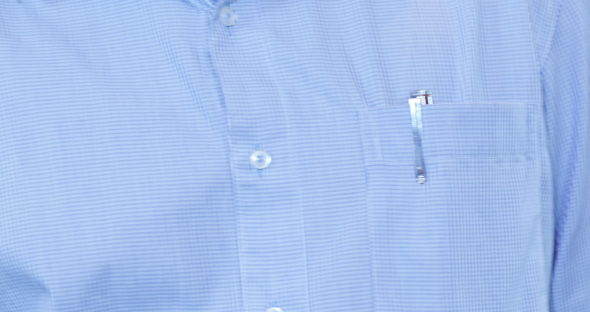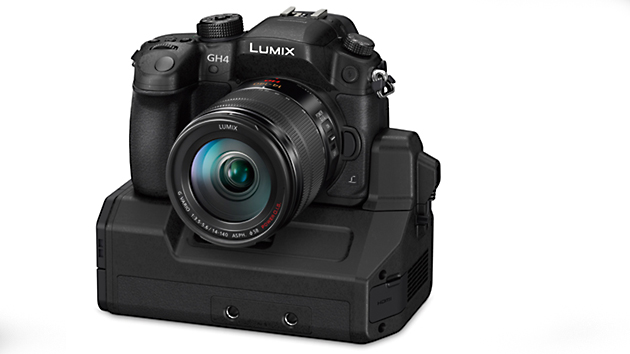Compelling Features, 10-Bit 200 Mbps Footage, and a Low Profile That Means No One Will Say Boo
It shoots remarkable images at 4K resolution, records 10-bit 4:2:2 in full HD at up to 200 Mbps, captures images from 2-96 fps, offers true professional balanced audio and 3G-SDI output to an external recorder or monitor. Recording internally to SD memory, the GH4 captures the higher resolutions (i.e. Cinema 4K 4096 x 2160 and UHD 3840 x 2160) in 8-bit 4:2:0 at up to 100 Mbps. One might logically question how Panasonic’s new AG-GH4U is anything less than a competent full-featured digital cinema camera.
The GH4, with its newly developed 16 megapixel micro-four-thirds sensor, boasts many of the attributes of a professional very high-resolution camera. The micro-four-thirds imager size is ideal for capturing the distinctive look of the cinema; the GH4 creates images that look and feel like 35mm as audiences have beheld the format for decades, which is certainly not the case if you choose to capture your latest epic with a double-frame DSLR.
The new camera shoots true Cinema 4K at 4096×2160, but only at 24 fps. That's 24.00 fps, like traditional film cameras. Shooters should be advised of the potential workflow issues arising from shooting at 24.00 rather than the far more common non-integral rate of 23.98 FPS. The GH4 also shoots 3840×2160 QFHD at 23.98, 24.00, and 29.97 FPS. Quad Full HD will likely be the resolution of choice for most GH4 shooters pursuing non-digital-cinema applications.
The AG-GH4U is ruggedly constructed and comparable in many ways to a full-fledged video camera. The ‘U’ version GH4 ships with the A/V interface module sporting dual XLR inputs and 3G-SDI output for capturing and viewing 4K.
Featurewise, the camera features single-frame and time-lapse capabilities in addition to, incredibly, a synchro-scan shutter adjustable in degrees for eliminating flicker when shooting out-of-sync monitors or overseas in a mismatched 50Hz/60Hz environment. Clearly, this is no ordinary consumer hybrid camera, as the GH4 is switchable for worldwide operation at 50 Hz or 60 Hz and offers fully settable time code in DF (drop-frame) or NDF (non-drop frame) modes.
A new series of rugged, better-performing Lumix lenses are available for the GH4. This screen shot from video captured at night in Makati, Philippines, exhibits no chromatic aberrations in the car headlights — strong testimony to the sophisticated processing taking place under the hood of the new camera.
The new digital single lens mirrorless, or DSLM, camera offers much better than average noise reduction, with an estimated 11 stops of latitude. This is based on actual evaluation of an industry-standard reference chart. While I'm hardly a fan of evaluating cameras based on a laboratory reference, my point is that the GH4 exhibits excellent exposure latitude with a wide dynamic range, which is especially impressive given the GH4’s modest price and still-camera roots.
The GH4 is virtually immune to moiré or banding, a common failing of many DSLRs and hybrids. My torture test in a Singapore cafe produced no perceivable moiré when panning across a patterned shirt.
The new model utilizes a re-designed optical low-pass filter (OLPF), which, in tandem with more efficient processing, effectively suppresses moiré without substantial resolution loss. Rolling shutter skewing has also been minimized, thanks to the higher frequency of data readouts from the sensor surface.
The GH4 captures FHD .mov files with all-I frame 4:2:2 compression at 10 bits up to 200 Mbps! The all-I-frame option in the GH4 is a variant of AVCHD and is not the same as AVC-Intra in Panasonic pro video cameras.
The gamma settings in the GH4 include Cinelike-D (the D is for dynamic range) that expands the middle (gamma) of the camera response curve to accommodate blacker blacks and whiter whites. The trade-off is an increased risk of detail loss in the shadows and an increased risk of clipping in the highlights. The setting, borrowed from Panasonic's Pro Video line, is ideal for feature films and most commercial work. Curiously, in the same menu, the GH4 offers the baffling and inscrutable VIVID and NATURAL options. Sure, this is supposed be a consumer camera. It’s like the consumer marketing people crashed the big boys’ party and this odd hodge-podge is the result.
Other evidence of the camera’s consumer pedigree? The thoughtful and kindly menu hints to newbie shooters, like ‘AVCHD Best for HDTV.’ If you’re shooting, say, Cinema 4K and outputting 3G-SDI via the A/V module, my sense is you probably don’t need or want the basic film-class references.
Beware the quagmire of cables! The AJA KiPro Quad supports a 24.00 FPS integral frame rate.
The GH4 supports 4K uncompressed recording via 3G-SDI to an external recorder like the Ki Pro Quad or via HDMI to a compatible device at 8- or 10-bit 4:2:2. Recording C4K .mov files to the internal SDXC card (UHS Speed Class 3 recommended) is necessarily more constrained, being limited to 24.00 FPS at 100Mbps. At 3840×2160 resolution the options expand considerably, allowing 23.98, 24.00, 25.00 and 29.97 FPS recording at 100Mbps. To facilitate workflow when capturing 4K. the output may be downconverted in real time to 1080p for viewing and/or an additional external recording.
The GH4 is unwieldy and difficult to hold with the A/V module mounted below. Most shooters will opt for a frame or compact rig to support the camera and the required accessories, increasing the camera's profile and reducing, at least in part, the advantage of shooting with a compact DSLM in the first place.
The A/V module offering 3G-SDI and balanced XLR audio is impressive at such a low price point. Unfortunately, mounting this module substantially compromises the weight and ergonomics of the GH4. The DC input and XLR audio plugs protrude awkwardly, and are positioned where the operator’s right hand would normally go. This means you really do require a rig to properly operate the camera with the A/V module attached, in order to mount a recorder, light, microphone, etc., and contain the sprawl of protruding cables.
Of course some compromise is to be expected when using a hybrid still camera. With the GH4’s bevy of professional video features it's easy to forget that.
Having to drill down through umpteen menus to change frame rate, shutter, or something else, it’s easy to miss the action! Like most still cameras, the GH4 has a menu layout that is poorly suited for the video professional.
The GH4U with its optional A/V module is a lot of imaging power to hold in the palm of your hand. For sure, no one will confuse this little camera with an ARRI Alexa, Canon C500, or Panasonic’s own VariCam 35. But the camera is undeniably impressive, and oh, so unobtrusive. You can take it pretty much anywhere — say, a red-light district or other sensitive location — and no one will say boo.










